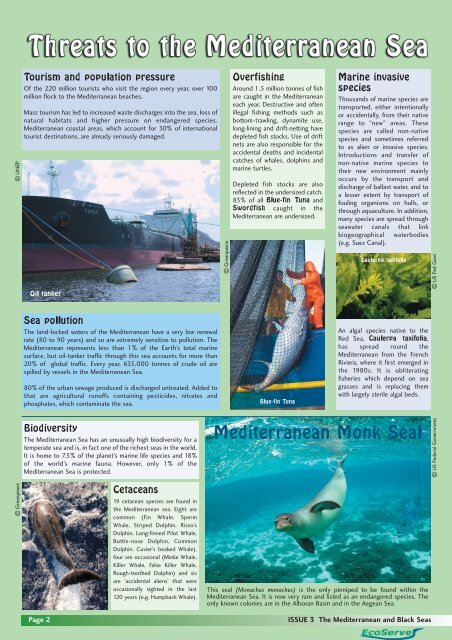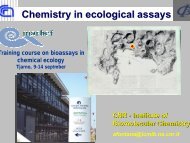Mediterranean Sea and Black Sea - MarBEF
Mediterranean Sea and Black Sea - MarBEF
Mediterranean Sea and Black Sea - MarBEF
You also want an ePaper? Increase the reach of your titles
YUMPU automatically turns print PDFs into web optimized ePapers that Google loves.
© UNEP<br />
© Greenpeace<br />
Tourism <strong>and</strong> population pressure<br />
Of the 220 million tourists who visit the region every year, over 100<br />
million flock to the <strong>Mediterranean</strong> beaches.<br />
Mass tourism has led to increased waste discharges into the sea, loss of<br />
natural habitats <strong>and</strong> higher pressure on endangered species.<br />
<strong>Mediterranean</strong> coastal areas, which account for 30% of international<br />
tourist destinations, are already seriously damaged.<br />
Oil tanker<br />
<strong>Sea</strong> pollution<br />
The l<strong>and</strong>-locked waters of the <strong>Mediterranean</strong> have a very low renewal<br />
rate (80 to 90 years) <strong>and</strong> so are extremely sensitive to pollution. The<br />
<strong>Mediterranean</strong> represents less than 1% of the Earth’s total marine<br />
surface, but oil-tanker traffic through this sea accounts for more than<br />
20% of global traffic. Every year, 635,000 tonnes of crude oil are<br />
spilled by vessels in the <strong>Mediterranean</strong> <strong>Sea</strong>.<br />
80% of the urban sewage produced is discharged untreated. Added to<br />
that are agricultural runoffs containing pesticides, nitrates <strong>and</strong><br />
phosphates, which contaminate the sea.<br />
Biodiversity<br />
The <strong>Mediterranean</strong> <strong>Sea</strong> has an unusually high biodiversity for a<br />
temperate sea <strong>and</strong> is, in fact one of the richest seas in the world.<br />
It is home to 7.5% of the planet’s marine life species <strong>and</strong> 18%<br />
of the world’s marine fauna. However, only 1% of the<br />
<strong>Mediterranean</strong> <strong>Sea</strong> is protected.<br />
Cetaceans<br />
19 cetacean species are found in<br />
the <strong>Mediterranean</strong> sea. Eight are<br />
common (Fin Whale, Sperm<br />
Whale, Striped Dolphin, Risso’s<br />
Dolphin, Long-finned Pilot Whale,<br />
Bottle-nose Dolphin, Common<br />
Dolphin, Cuvier’s beaked Whale),<br />
four are occasional (Minke Whale,<br />
Killer Whale, False Killer Whale,<br />
Rough-toothed Dolphin) <strong>and</strong> six<br />
are ‘accidental aliens’ that were<br />
occasionally sighted in the last<br />
120 years (e.g. Humpback Whale).<br />
© Greenpeace<br />
Overfishing<br />
Around 1.5 million tonnes of fish<br />
are caught in the <strong>Mediterranean</strong><br />
each year. Destructive <strong>and</strong> often<br />
illegal fishing methods such as<br />
bottom-trawling, dynamite use,<br />
long-lining <strong>and</strong> drift-netting have<br />
depleted fish stocks. Use of drift<br />
nets are also responsible for the<br />
accidental deaths <strong>and</strong> incidental<br />
catches of whales, dolphins <strong>and</strong><br />
marine turtles.<br />
Depleted fish stocks are also<br />
reflected in the undersized catch.<br />
83% of all Blue-fin Tuna <strong>and</strong><br />
Swordfish caught in the<br />
<strong>Mediterranean</strong> are undersized.<br />
Blue-fin Tuna<br />
Marine invasive<br />
species<br />
Thous<strong>and</strong>s of marine species are<br />
transported, either intentionally<br />
or accidentally, from their native<br />
range to “new” areas. These<br />
species are called non-native<br />
species <strong>and</strong> sometimes referred<br />
to as alien or invasive species.<br />
Introductions <strong>and</strong> transfer of<br />
non-native marine species to<br />
their new environment mainly<br />
occurs by the transport <strong>and</strong><br />
discharge of ballast water, <strong>and</strong> to<br />
a lesser extent by transport of<br />
fouling organisms on hulls, or<br />
through aquaculture. In addition,<br />
many species are spread through<br />
seawater canals that link<br />
biogeographical waterbodies<br />
(e.g. Suez Canal).<br />
Caulerpa taxifolia<br />
An algal species native to the<br />
Red <strong>Sea</strong>, Caulerpa taxifolia,<br />
has spread round the<br />
<strong>Mediterranean</strong> from the French<br />
Riviera, where it first emerged in<br />
the 1980s. It is obliterating<br />
fisheries which depend on sea<br />
grasses <strong>and</strong> is replacing them<br />
with largely sterile algal beds.<br />
<strong>Mediterranean</strong> Monk <strong>Sea</strong>l<br />
This seal (Monachus monachus) is the only pinniped to be found within the<br />
<strong>Mediterranean</strong> <strong>Sea</strong>. It is now very rare <strong>and</strong> listed as an endangered species. The<br />
only known colonies are in the Alboran Basin <strong>and</strong> in the Aegean <strong>Sea</strong>.<br />
Page 2 ISSUE 3 The <strong>Mediterranean</strong> <strong>and</strong> <strong>Black</strong> <strong>Sea</strong>s<br />
© US Federal Government © US Fed Govt




